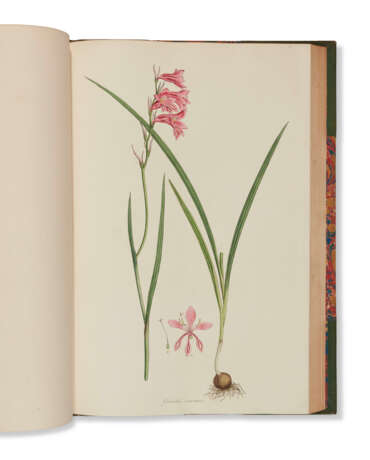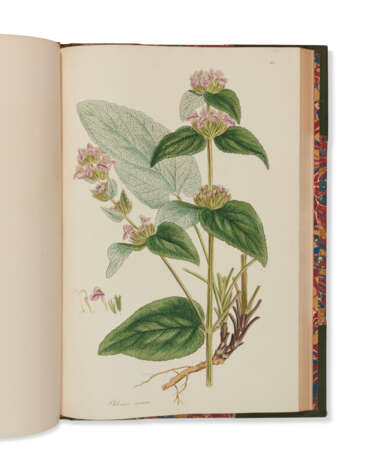ID 1079720
Lot 90 | SIBTHORP, John (1758-1796), Sir James Edward SMITH (1759-1828) et John LINDLEY (1799-1865)
Estimate value
€ 80 000 – 120 000
Flora Graeca : sive plantarum rariorum historia, quas in provinciis aut insulis Graeciae. Londres : 1806-1840 [1845].
Exemplaire complet des 966 planches coloriées à l'époque de l'un des plus luxueux ouvrages de botanique. C'est John Sibthorp, professeur de botanique et directeur du jardin botanique d'Oxford, qui fut à l'origine de cette périlleuse aventure éditoriale autour de la flore du Levant et des Balkans. Il effectua un premier voyage en Grèce entre 1786 et 1787, accompagné de l'artiste autrichien Ferdinand Bauer et du naturaliste John Hawkins. De retour à Oxford, Sibthorp entreprit une classification des plantes observées, tandis que Bauer travailla aux aquarelles finales d'après les esquisses réalisées sur place. Les fleurs de Bauer sont dessinées "avec une immense précision dans le moindre détail", et l'artiste se révèle également être "un paysagiste sensible et inspiré" pour traduire la grandeur des paysages grecs présents sur les titres gravés (Pinault Sorensen). Entre 1794 et 1795, Sibthorp organisa une seconde expédition en Turquie et dans le Péloponèse et mourut peu après son retour, laissant des fonds pour mener à bien la publication de l'ouvrage, en 10 volumes comprenant 100 planches chacun. C'est James Edward Smith qui prit la direction de l'édition pour les volumes 1 à 7, puis John Lindley pour les volumes 8 à 10. Le coût de prodution de l'édition, achevée plus de quarante ans après la disparition de Sibthorp, dépassa les 30 000 £, et seulement 30 souscriptions furent recueillies – probablement à cause du coût exorbitant de 254 £ pour chaque ensemble de 10 volumes. Sur ces 30 souscirptions, seuls 25 exemplaires furent produits, chaque ensemble vendu à 254 £ revenant donc à plus de 1000 £ ! Entre 1845 et 1846, Henry Bohn publia une ré-impression de 40 exemplaires, reconnaissable par le filigrane daté 1845 présent sur un certain nombre de planches, comme c'est le cas sur cet exemplaire. Sitwell, Great Flower Books, p. 179 ; Nissen, 1840 ; Pritzel, 8660 ; Stafleu, 11.935 ; Blunt & Stearn, The Art of Botanical Illustration, pp. 195-196 ; Pinault Sørensen, Le livre de botanique, XVIIe et XVIIIe siècles, pp. 202-203 ; Stearn, Taxon, "Sibthorp, Smith, the ‘Flora Graeca’ and the ‘Florae Graecae Prodromus'", pp. 168-178 ("the most costly and magnificent of Floras").
"One of the rarest and most beautiful in both plates and typography of all botanical works" (Sitwell)
10 vol. in-folio (475 x 322 mm). Illustré de 10 titres gravés coloriés à l'époque et 966 planches d'après Ferdinand Bauer, gravées par James Sowerby et James de Carle Sowerby, coloriées à la main à l'époque (la planche 288 n'est pas entièrement coloriée). Vol. 1 : feuillets de texte brunis, mouillure au titre gravé. Reliure uniforme de l'époque : demi-maroquin vert à coins, dos orné de filets, roulettes et petits fers floraux dorés, tranches dorées (dos passés, mors et cuir très frottés, accrocs aux plats avec manques de cuir, mors supérieur fendu et plat partiellement détaché au vol. 2).
Provenance : James de Rothschild (ex-libris et étiquette "Ferrières" au contreplat de chaque volume)
One of the most beautiful books on botany, this one complete with the 966 hand-colored plates.
| Artist: | James Edward Smith (1759 - 1828) John Lindley (1799 - 1865) John Sibthorp (1758 - 1796) |
|---|---|
| Place of origin: | Northern Europe, Europe, United Kingdom |
| Auction house category: | Books |
| Artist: | James Edward Smith (1759 - 1828) John Lindley (1799 - 1865) John Sibthorp (1758 - 1796) |
|---|---|
| Place of origin: | Northern Europe, Europe, United Kingdom |
| Auction house category: | Books |
| Address of auction |
CHRISTIE'S 9 Avenue Matignon 75008 Paris France | ||||||||||||||
|---|---|---|---|---|---|---|---|---|---|---|---|---|---|---|---|
| Preview |
| ||||||||||||||
| Phone | +33 (0)1 40 76 85 85 | ||||||||||||||
| Fax | +33 (0)1 40 76 85 86 | ||||||||||||||
| Conditions of purchase | Conditions of purchase | ||||||||||||||
| Shipping |
Postal service Courier service pickup by yourself | ||||||||||||||
| Payment methods |
Wire Transfer | ||||||||||||||
| Business hours | Business hours
|




























